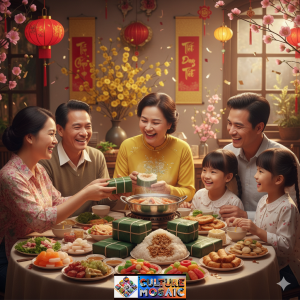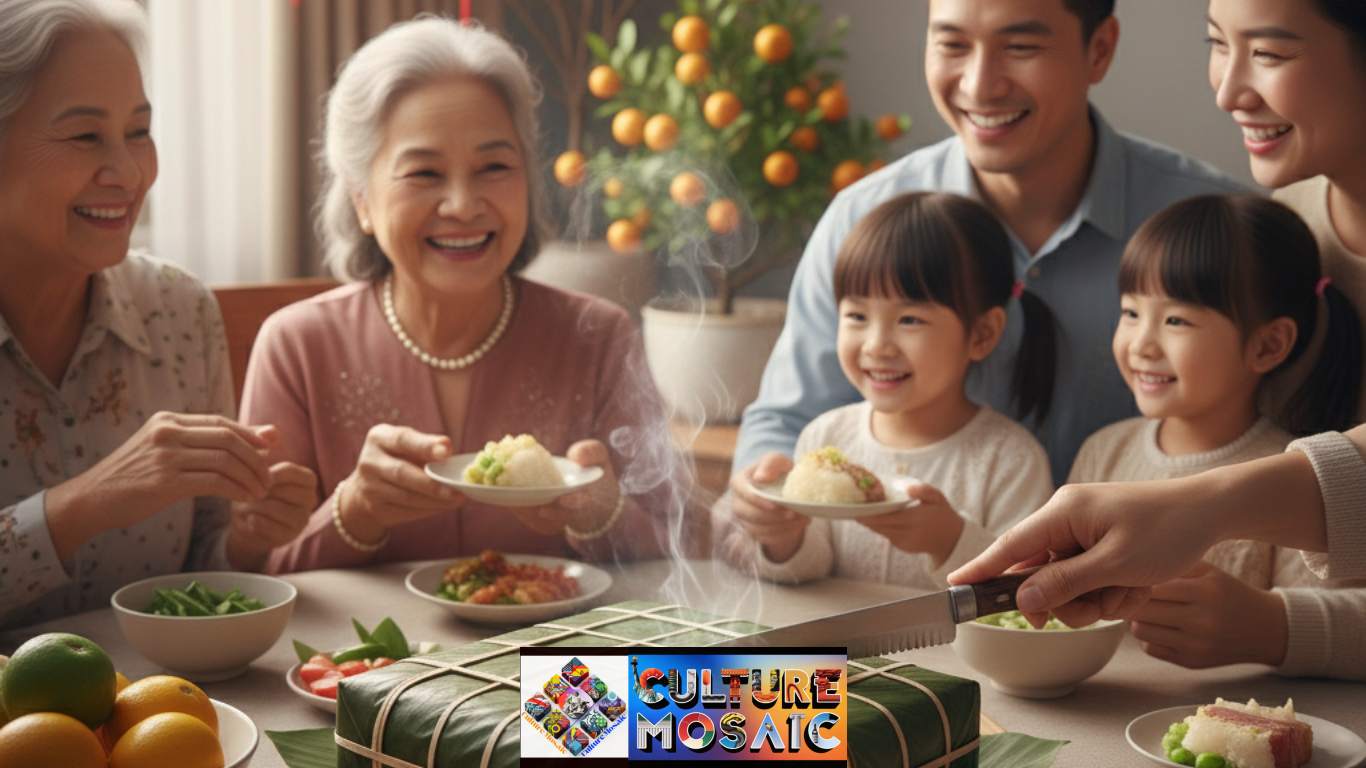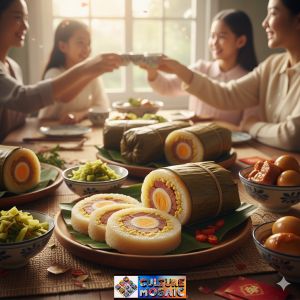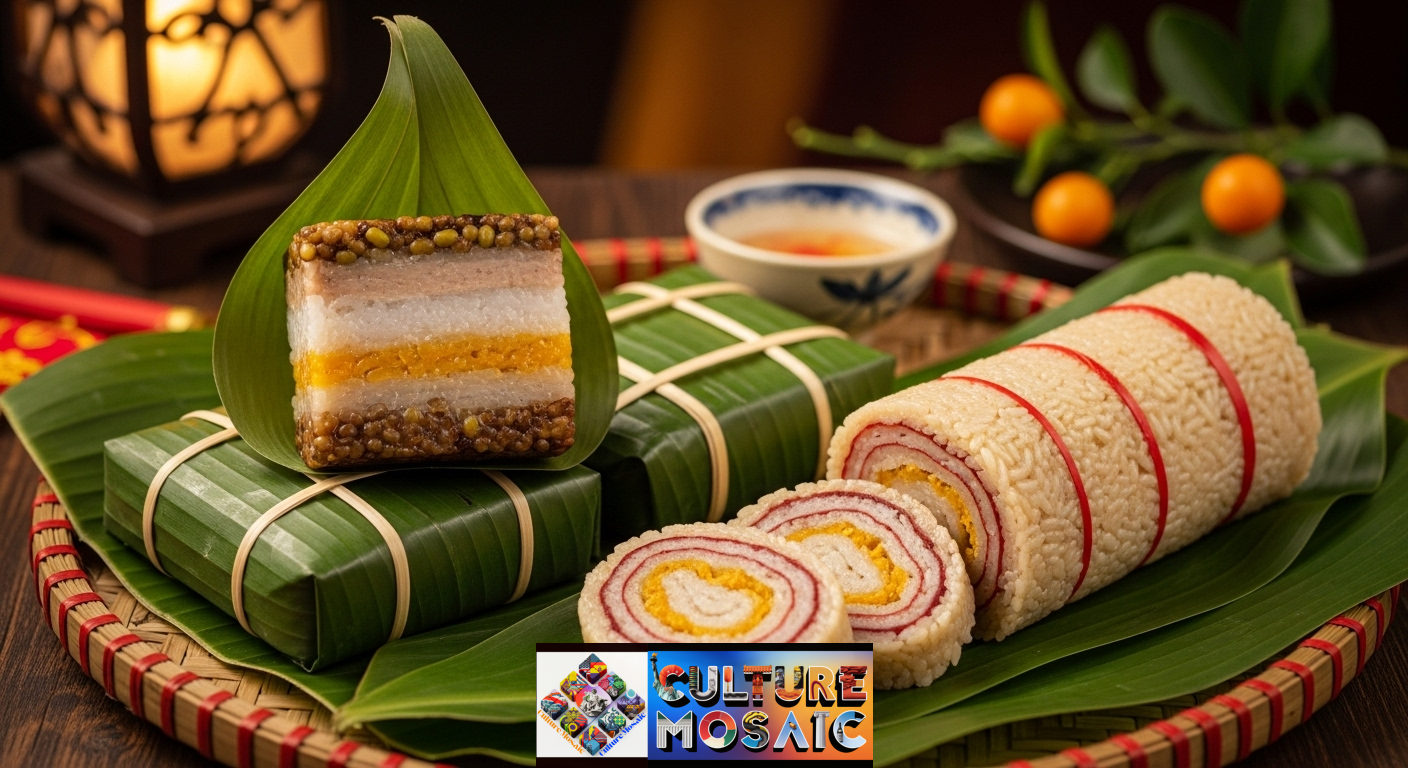Introduction
As the Lunar New Year approaches, Vietnamese families gather to share Bánh chưng and Bánh tét, rice cakes that spark joy and togetherness. In our Civic Voices exploration of festive dishes make happy, we dive into the heart of Tết, Vietnam’s most cherished festival, to uncover how these iconic rice cakes spread happiness through tradition and community. Through their rich symbolism and an exclusive interview with a Vietnamese family in London, we reveal how Bánh chưng and Bánh tét weave stories of heritage, resilience, and celebration.
Tết: A Festival of Joy and Renewal

Tết, the Vietnamese Lunar New Year, celebrated in late January or early February (February 7-9, 2026, for the upcoming cycle), is a time of renewal, family reunions, and honoring ancestors. At its core are Bánh chưng and Bánh tét, rice cakes that embody joy and cultural pride.
-
Historical Context: Rooted in the 6th-century legend of Prince Lang Liêu, who created Bánh chưng to honor King Hùng Vương VI, these cakes symbolize Earth (square) and sky (cylindrical), reflecting gratitude and hope.
-
Cultural Role: Prepared and shared during Tết, they strengthen family bonds and invite prosperity, making them true festive dishes make happy.
-
Community Impact: From Hanoi’s markets to London’s Vietnamese enclaves, these rice cakes unite communities, spreading joy through shared meals.
These dishes prove that festive dishes make happy by connecting hearts across generations.
Bánh Chưng: The Square of Earth and Togetherness

Why does Bánh chưng bring joy to Tết? Its square shape and layered ingredients create happiness through unity and tradition.
-
Preparation and Symbolism: Made with glutinous rice (people), mung beans (harvest), pork (prosperity), and green beans, wrapped in banana leaves, Bánh chưng represents Earth. Boiling it for hours is a family affair, fostering togetherness.
-
Cultural Significance: In northern Vietnam, families make Bánh chưng to offer at ancestral altars and share with loved ones, spreading joy during Tết.
-
Festive Dishes Make Happy: From ancient royal courts to modern diaspora homes in London, Bánh chưng’s preparation and sharing spark smiles and memories.
Slicing Bánh chưng weaves you into festive dishes make happy, uniting families.
Bánh Tét: The Cylindrical Symbol of Growth

Why does Bánh tét light up Tết celebrations? Its cylindrical shape and vibrant fillings embody hope and festivity.
-
Preparation and Symbolism: Crafted with glutinous rice, mung beans, and sometimes banana or salted egg, wrapped in banana leaves, Bánh tét symbolizes the sky and growth. Its round shape reflects life’s cyclical renewal.
-
Cultural Significance: In southern Vietnam, Bánh tét is paired with pickled vegetables or braised pork, shared to celebrate abundance and joy.
-
Festive Dishes Make Happy: Bánh tét’s regional variations connect southern Vietnamese traditions to diaspora communities, spreading happiness worldwide.
Serving Bánh tét embodies festive dishes make happy, inspiring hope and connection.
Community Voices: An Interview with a Vietnamese Family
To illuminate how festive dishes make happy, we spoke with the Nguyen family, Vietnamese immigrants running a small eatery in London’s Shoreditch. They share their Tết traditions around Bánh chưng and Bánh tét.
-
Memories of Tết: Linh, the matriarch, recalls her mother in Hanoi teaching her to wrap Bánh chưng. “Boiling the cakes all night fills our home with joy,” she says.
-
Passing Down Tradition: Linh’s daughter, Mai, learned the recipe in London, using local ingredients. “Making Bánh chưng makes me feel close to Vietnam,” Mai shares.
-
Community Impact: The Nguyens host a Tết pop-up, serving rice cakes to London’s Vietnamese community and curious locals, spreading happiness through shared flavors.
Their story shows how festive dishes make happy by preserving heritage across borders.
Tết Rice Cakes in Modern Celebrations
Bánh chưng and Bánh tét remain central to Tết, from Hanoi’s bustling markets to London’s Vietnamese neighborhoods. At Notting Hill’s Portobello Market, vendors sell banana leaves and rice, enabling diaspora families to recreate these dishes. Restaurants like Viet Grill in London serve rice cakes during Tết, blending tradition with modern flair. These festive dishes make happy by uniting communities through shared meals and cultural pride.
Why These Dishes Endure
Festive dishes make happy because they carry stories of family, resilience, and joy. Bánh chưng and Bánh tét embody the voices of families like the Nguyens, who keep Tết traditions alive in new lands. In a fast-paced world, these rice cakes remind us of slow, intentional rituals, connecting us to Vietnam’s heritage and global communities.
How to Explore Festive Dishes Make Happy
Want to dive into festive dishes make happy? Here’s how:
-
Cook Bánh Chưng or Bánh Tét: Try a recipe from Vietnamese cookbooks or online guides, savoring their symbolic joy.
-
Visit Vietnamese Markets: Explore stalls in Shoreditch or Notting Hill’s Portobello Market for Tết ingredients and vendor stories.
-
Join Tết Celebrations: Attend Vietnamese Lunar New Year events to taste rice cakes and hear community tales.
-
Learn More: Read Vietnamese Food Any Day by Andrea Nguyen or visit cultural exhibits for deeper insights into Tết traditions.
Conclusion
Festive dishes make happy through the vibrant stories of Bánh chưng and Bánh tét, which light up Tết with tradition and joy. From their ancient origins to modern Vietnamese kitchens in London, these rice cakes carry the voices of families and communities. As you savor their sticky, savory layers, you’re part of a centuries-old celebration. Join Civic Voices in celebrating how festive dishes make happy, uniting us across cultures.
FAQs
How do festive dishes make happy in Vietnamese culture?
Festive dishes make happy through Bánh chưng and Bánh tét, which unite families during Tết with their symbolic preparation and sharing.
Why is Bánh chưng key to festive dishes make happy?
Bánh chưng, a square rice cake symbolizing Earth, spreads joy during Tết by fostering family togetherness and honoring ancestors.
How does Bánh tét embody festive dishes make happy?
Bánh tét, a cylindrical rice cake, represents growth and brings happiness to southern Vietnamese Tết celebrations through shared meals.
How do families share festive dishes make happy?
Families like the Nguyens in London pass down Bánh chưng recipes, creating joyful memories and preserving Vietnamese heritage.
Where can I explore festive dishes make happy in London?
Visit Shoreditch’s Vietnamese eateries or Notting Hill’s markets during Tết to taste rice cakes and hear community stories.

